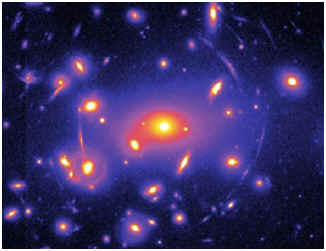|
FALSE ALARMS |
||||
|
the forward scattering of |
||||
|
INTENSE LIGHT |
||||
|
Abell 2218 |
||||
|
|
The thin
curved arcs,
shown here surrounding the bright galaxy cluster, are typically shown
and illustrated in practically all Astronomy magazines and textbooks.
These images are the magnified images of distant galaxies that have been
allegedly magnified or gravitationally
lensed by the powerful gravity of the galaxy cluster Abell 2218.
NASA/ESA |
|||
|
||||
|
Galaxy Cluster 0024+1654 |
||||
|
|
Magnified images of distant galaxies that have been allegedly gravitationally lensed by the gravity of the galaxy cluster 0024+1654. Galaxy Cluster 0024+1654, W.N. Colley (Princeton University), E. Turner (Princeton University), J.A. Tyson (AT&T Bell Labs) and NASA |
|||
|
Abell 1689 |
||||
|
|
Taken with Advanced Camera for Surveys on NASA's Hubble Space Telescope. Allegedly, faraway
galaxies appear in the Hubble image as arc-shaped objects around the
cluster Abell 1689 and are magnified "zoom lensed" by
gravitational lensing. |
|||
|
Abell 370 |
||||
|
|
NASA, ESA, Hubble SM4 ERO Team, ST-ECF, September 9th, 2009 A close-up Abell 370, nearly 5 billion light-years away, is alleged to have been gravitationally lensed, where the warping of space by the cluster's gravitational field distorts the light from galaxies lying far behind it. This is manifested as arcs and streaks in the picture, which are the stretched images of background galaxies. |
|||
|
Abell 383 |
||||
|
|
Abell
383, alleged to be a gravitational lens, was used to find a galaxy so
far away that we see it as it was less than a billion years after the
Big Bang. This distant galaxy's light has been warped into two, very
faint images that are hard to see in this view. Image credit: NASA, ESA, CRAL, LAM, STScI |
|||
|
||||
|
Galaxy Cluster RCS2 032727-132623 |
||||
|
|
Allegedly,
the background galaxy appears 20 times larger and over three times
brighter than typically lensed galaxies.
Hubble Space Telescope, released Feb. 2, 2012, shows distant galaxy 10 billion light-years away through gravitational lens around the galaxy cluster RCS2 032727-132623 about 5 billion light-years away. NASA, ESA |
|||
|
||||
REFERENCES
|
||||
|
|
||||





